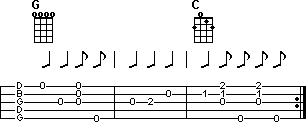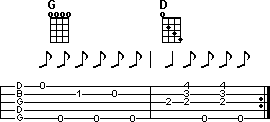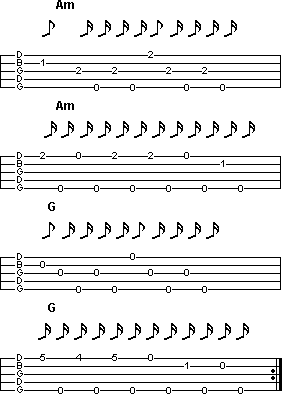3/4 and 6/8 Timing
We’ve covered 4/4 time pretty extensively up to this point. Now let’s take a look at two other common time signatures you will run into on the banjo.
3/4 Time
In 3/4 time we are playing three notes to a measure with the quarter note getting the beat.
What that means is that your count is 1 2 3, 1 2 3.
That’s it. Everything you worked with in 4/4 time stays the same but now we are working with a different count.
Example One

In this example we have the basic frailing pattern adapted to 3/4 time. We are playing a quarter note followed by two eighth note strum-thumbs.
The count is 1 2& 3&, 1 2& 3&.
Work with this pattern and give yourself some time to get used to the new rhythm.
As you get more comfortable you can start applying the ideas we discussed in the timing chapter for 4/4 time to the 3/4 count.
Example Two

In this example we are breaking up the measures in three four time the same way we did earlier in 4/4 time. In the first measure we are playing two quarter notes and two eighth notes. In the second measure we are playing three quarter notes. In the third measure we are playing a quarter note and four eighth notes.
The count is 1 2 3&, 1 2 3, 1 2& 3&.
Example Three

In this example we are using the double thumb in the first measure and a basic frailing pattern over a D chord in the second measure.
The count is 1& 2& 3&, 1 2& 3&.
6/8 Time
In 6/8 time we are playing six eighth notes in every measure with the eighth note getting the beat. 6/8 is also a triplet time. That means that your eighth notes are in groups of three so you count for each measure is 1 2 3 2 2 3.
This is entirely different from 4/4 time where we are counting 1 2 3 4 in each measure. In 6/8 we are counting two three beat patterns in each measure.
Because of that, and because we are working with eighth notes rather than quarter notes, we can’t effectively use the basic frailing strum in 6/8 time. We have to come up with something different.
Example One

In this example we have a measure in 6/8 time. The note sequence is an eighth note followed by four sixteenth notes. A sixteenth note is one half the value of an eighth note so our count becomes 1 2& 3& 2 2& 3&.
I am using sixteenth notes here because it helps to put the emphasis on the first eighth note in each group of three. Just running six eighth notes right off the bat would make it difficult to get the feel of this rhythm pattern.
This is another pattern where practicing with the proper picking hand technique really pays off. The sixteenth notes just don’t leave you any time to fish around for a string.
Example Two

In this example we have changed the pattern into a run of twelve sixteenth notes. The count is 1& 2& 3& 2& 2& 3&.
Example Three

In example three we have a chord progression made up of two measures of Am and two measures of G.
The count for example three is 1 2& 3& 2 2& 3& in the first measure, 1& 2& 3& 2& 2& 3& in the second measure,
1 2& 3& 2 2& 3& in the third measure and 1& 2& 3& 2& 2& 3& in the fourth measure.
The one thing about frailing in 6/8 time is that there usually isn’t much room for the kind of timing tricks we can employ in 4/4 and 3/4 time. A hammer-on in a run of sixteenth notes is going to result in two thirty-second notes. It’s possible, but your timing has to be dead on to make it work.
One little trick you can use to help you keep track of tunes in 6/8 time is to “McTavish” the beat.
A lot of 6/8 time tunes like “Irish Washerwoman,” the B part of “Garryowen,” or even example three on the last page have a rhythm that fits this little bit of verse:
McTavish is dead and his brother don’t know it.
His brother is dead and McTavish don’t know it.
There’s two Irish guys lying in bed,
neither one knows that the other one’s dead.
Okay, it’s slightly warped, but that little poem has helped me phrase out some pretty complicated 6/8 tunes. It won’t work for everything, but it has gotten me out of some tight spots in jams where a lot of Irish music was being played.
On a completely unrelated note, you can sing almost every poem written by Emily Dickenson to the tune of “Yellow Rose of Texas”.